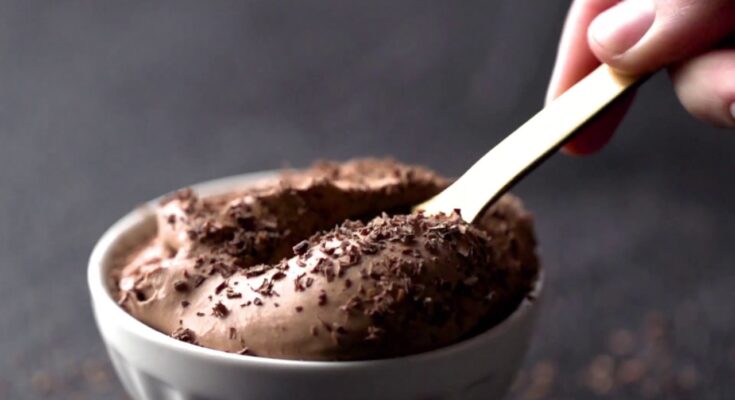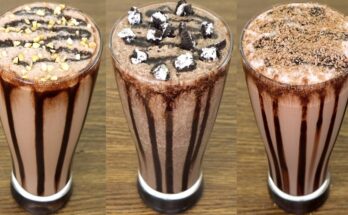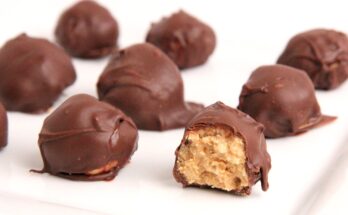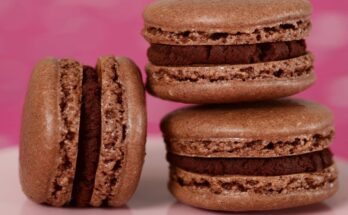Chocolate Recipe: There’s something magical about making chocolate at home. It’s not just about the taste—it’s the joy of creating something from scratch, turning simple ingredients into a silky, melt-in-your-mouth treat. Store-bought chocolate is convenient, but let’s be honest—it often contains preservatives, artificial flavors, and way too much sugar. When you make chocolate at home, you control everything: the sweetness, the richness, the creaminess, and even the little flavor twists that make it uniquely yours.
Homemade chocolate is also fresher, and it allows you to experiment. Want a spicy kick? Add chili powder. Love crunch? Mix in nuts. Prefer something creamy and smooth? Go for milk or coconut cream variations. With homemade chocolate, the possibilities are endless, and every batch is a delicious adventure.
Beyond taste, making chocolate can be therapeutic. Melting, mixing, and pouring feels like a mini science experiment in your kitchen. It’s creative, fun, and rewarding—especially when you share it with friends or family. And honestly, who doesn’t want to brag, “I made this chocolate myself”?
Why Make Chocolate at Home?
The biggest reason to make chocolate at home is control over ingredients. Many commercial chocolates contain additives, artificial sweeteners, or palm oil. At home, you can keep it clean and natural—using just cocoa butter, cocoa powder, and a sweetener of your choice.
Another reason is customization. Not a fan of overly sweet chocolate? Reduce the sugar. Want a hint of sea salt or caramel? Add it. Have dietary restrictions? Make it vegan or sugar-free. You become the chocolatier of your kitchen.
Also, it’s often more cost-effective in the long run. Buying high-quality chocolate bars can get pricey, but with a small investment in cocoa powder and cocoa butter, you can create several batches. Homemade chocolate also makes for thoughtful gifts—a box of your handmade treats feels personal, special, and much more meaningful than store-bought candy.
And let’s not forget the fun factor. Making chocolate is a hands-on activity that kids and adults alike can enjoy. It’s like cooking, crafting, and indulging all rolled into one sweet hobby.
Benefits of Homemade Chocolate Over Store-Bought
Homemade chocolate has a lot going for it, and once you try it, you might never look at store-bought bars the same way again. Here are some clear advantages:
- Healthier Option – You decide the level of sweetness and fat. Store chocolates are often overloaded with sugar, while homemade versions can be made with honey, maple syrup, or coconut sugar for a natural touch.
- Diet-Friendly – Whether you’re vegan, keto, or dairy-free, homemade chocolate can be adapted to fit your lifestyle.
- No Preservatives or Fillers – Store-bought brands often use emulsifiers, oils, or artificial flavor enhancers. With homemade chocolate, it’s pure cocoa goodness.
- Flavor Experiments – Ever dreamed of lavender-infused chocolate or cinnamon-spiced bars? You can make it happen at home.
- Sustainability – Buying raw ingredients in bulk reduces packaging waste compared to individually wrapped commercial chocolates.
At the end of the day, homemade chocolate isn’t just about taste—it’s about making better choices for your health, wallet, and creativity.
Ingredients You’ll Need
Core Ingredients for Basic Chocolate
To make a simple, classic chocolate bar, you only need a few key ingredients:
- Cocoa butter – This gives chocolate its smooth, silky texture.
- Cocoa powder – Provides that deep, rich chocolate flavor.
- Sweetener – Options include cane sugar, honey, agave, stevia, or coconut sugar.
- Vanilla extract – Adds a warm, aromatic depth.
- Pinch of salt – Enhances and balances the sweetness.
These ingredients form the base of almost every chocolate recipe, and from here, you can experiment with endless variations.
Optional Additions for Flavor and Texture
This is where the fun begins! Depending on your taste, you can add:
- Nuts (almonds, hazelnuts, peanuts, pistachios)
- Dried fruits (cranberries, raisins, cherries)
- Spices (cinnamon, chili powder, cardamom)
- Flavor extracts (mint, orange, almond)
- Superfoods (chia seeds, hemp hearts, matcha)
You can even swirl in peanut butter or caramel for layered flavors.
Choosing the Right Quality Ingredients
The quality of your chocolate depends on the quality of your ingredients. For cocoa butter, always choose food-grade, organic options. For cocoa powder, go for unsweetened, pure cocoa powder (Dutch-processed or natural, depending on your flavor preference).
As for sweeteners, natural ones like honey or maple syrup not only taste better but also add nutritional value. If you prefer refined sugar, choose fine granulated so it blends smoothly.
Remember: the better your ingredients, the better your final chocolate will taste.
Essential Tools and Equipment
Kitchen Tools Required
Making chocolate doesn’t require a professional setup. Here’s what you’ll need:
- Heatproof bowl (glass or stainless steel)
- Saucepan (for double-boiling cocoa butter)
- Whisk or spatula (for mixing ingredients)
- Chocolate molds (silicone molds are best for easy removal)
- Measuring cups/spoons (accuracy is key in chocolate making)
Alternatives if You Don’t Have Specialized Tools
No chocolate molds? No problem. You can pour melted chocolate into:
- An ice cube tray
- A lined baking dish (then break into chunks)
- Muffin tins (for thicker pieces)
If you don’t have a double boiler, place a heatproof bowl over a pot of simmering water—it works just the same.
The truth is, chocolate-making is surprisingly simple—you don’t need fancy gadgets, just a little patience and creativity.
Step-by-Step Guide to Making Chocolate
Step 1 – Preparing Your Ingredients
Preparation is the backbone of great chocolate-making. Before you even touch the stove, measure all your ingredients. This isn’t like tossing together a salad—you’ll want precision. Chocolate depends on the right balance of fat (from cocoa butter), flavor (from cocoa powder), and sweetness (from sugar or your chosen alternative).
Start by chopping your cocoa butter into small, uniform pieces. This helps it melt evenly and prevents burning. Measure out your cocoa powder, ensuring it’s sifted so there are no clumps. If you’re using granulated sugar, grind it into a fine powder first; otherwise, it might not dissolve properly, leaving your chocolate grainy.
At this stage, you should also prepare your molds or trays. Line them with parchment if needed, or lightly oil them if you’re using something like a muffin tin. If you plan to add nuts, fruits, or spices, have them ready in small bowls.
Think of this step like setting the stage before the performance—the smoother your preparation, the smoother the process.
Step 2 – Melting Cocoa Butter
Cocoa butter is delicate, and rushing this step can ruin your chocolate. The best way to melt it is using the double boiler method. Place a heatproof bowl over a saucepan of simmering water. Make sure the bottom of the bowl doesn’t touch the water—steam is enough to melt it gently.
Add your chopped cocoa butter into the bowl and stir occasionally with a spatula or whisk. Patience is key here. If you heat cocoa butter too quickly, it can separate or develop an off flavor.
For those who prefer convenience, you can use a microwave in short bursts (15–20 seconds at a time), stirring in between. But be extra careful—microwaves can create hot spots that scorch your butter.
By the end of this step, you should have a bowl of silky, golden liquid cocoa butter. This is the base of your chocolate, the foundation that determines texture and richness.
Step 3 – Mixing Cocoa Powder and Sweetener
Once the cocoa butter is fully melted, it’s time to transform it into chocolate. Slowly whisk in your cocoa powder. Add it gradually, stirring well each time to prevent lumps. The mixture should darken and become smooth and glossy.
Next, add your sweetener of choice. If you’re using powdered sugar, sift it in slowly while whisking. For liquid sweeteners like honey or maple syrup, pour them in a thin stream, whisking continuously. This ensures they blend smoothly into the cocoa butter without separating.
At this point, you can add a pinch of salt (to balance sweetness) and vanilla extract for extra depth. If you’re feeling adventurous, fold in extras like nuts, coconut flakes, or chili powder for a custom flavor twist.
The key here is balance. Too much cocoa powder makes it bitter; too much sweetener makes it cloying. Adjust gradually, tasting as you go, until you hit your perfect chocolate flavor.
Step 4 – Tempering the Chocolate
Tempering is the step that separates average homemade chocolate from professional-quality bars. It’s the process of carefully controlling the chocolate’s temperature so it sets with a smooth, glossy finish and that signature “snap” when you break it.
Here’s a simple home method:
- After mixing, remove your bowl from heat.
- Stir continuously as the chocolate cools slightly (to about 80–82°F / 27–28°C).
- Warm it gently again over your double boiler, bringing it back up to around 88–90°F (31–32°C) for dark chocolate.
This cycle helps the cocoa butter crystals align properly, preventing chocolate from turning dull or crumbly.
If tempering feels too complicated, don’t worry—your chocolate will still taste great, even if it’s not glossy. But if you want that store-bought shine, tempering is the secret.
Step 5 – Pouring into Molds and Cooling
With your chocolate tempered and ready, it’s time for the most satisfying part—pouring it into molds. Gently spoon or pour your mixture into prepared silicone molds, ice cube trays, or a parchment-lined dish. Tap the mold lightly on the counter to release any air bubbles and smooth the surface.
If you’ve planned add-ins like nuts, fruit, or sprinkles, now’s the moment to sprinkle them on top or mix them in before the chocolate sets.
For cooling, avoid rushing the process. Place the molds in the refrigerator for 20–30 minutes or until completely set. Don’t freeze them—rapid cooling can cause uneven texture or white streaks (called bloom) on the chocolate.
Once hardened, pop your chocolate out of the molds. If tempered correctly, it should shine and snap beautifully. Congratulations—you’ve just made your own chocolate from scratch!
Variations of Homemade Chocolate
Dark Chocolate
Dark chocolate is the simplest version, made with cocoa butter, cocoa powder, and a minimal amount of sweetener. It’s rich, bold, and perfect for those who love an intense chocolate experience. To make it extra indulgent, you can add a hint of espresso powder or sea salt.
Milk Chocolate
Milk chocolate requires the same base but includes milk powder or condensed milk to give it that creamy sweetness. It’s softer on the palate, making it a family favorite. You can adjust the ratio of cocoa powder to milk powder depending on how “milky” you want it.
White Chocolate
Technically, white chocolate doesn’t contain cocoa powder at all. Instead, it’s made with cocoa butter, sugar, and milk powder. It’s smooth, buttery, and pairs beautifully with flavors like vanilla, lemon, or raspberry.
Vegan Chocolate
For a dairy-free option, skip milk powder and use coconut milk powder or almond milk powder instead. Sweeten with maple syrup or coconut sugar for a natural twist. Vegan chocolate can be just as creamy and flavorful as traditional recipes.
Tips for Perfect Homemade Chocolate
Common Mistakes and How to Avoid Them
Making chocolate at home sounds simple, but a few small errors can make or break the final result. One of the most common mistakes is overheating cocoa butter. If it gets too hot, the butter can burn, leaving your chocolate with a bitter, unpleasant taste. To avoid this, always melt slowly using the double boiler method, never direct heat.
Another mistake is not sifting cocoa powder or sugar. Lumps may seem harmless, but they ruin the smooth texture of chocolate. A quick sift ensures everything blends evenly.
Using the wrong sweetener can also cause problems. Liquid sweeteners like honey can sometimes cause the chocolate to seize (turn grainy and stiff). If you prefer liquid sweeteners, add them very slowly and whisk continuously. Otherwise, stick to powdered sugar or stevia for easier blending.
Lastly, many beginners skip tempering because it feels complicated. While untempered chocolate still tastes good, it can look dull, feel waxy, or crumble instead of snapping. If you want professional-quality chocolate, don’t skip tempering.
A little patience, attention to detail, and proper preparation can transform your homemade chocolate from “good” to “wow!”
How to Store Your Chocolate
Once you’ve made your delicious batch, proper storage is key to maintaining its texture and flavor. Chocolate is sensitive to both temperature and humidity. Ideally, store it in a cool, dry place, between 60–70°F (15–21°C). Avoid refrigerating unless absolutely necessary, as moisture can cause sugar bloom (white spots on the surface).
If you must refrigerate, wrap your chocolate tightly in parchment paper or foil, then place it in an airtight container to keep out moisture. When bringing it back to room temperature, let it sit in the container before unwrapping to prevent condensation from forming.
Homemade chocolate usually lasts about 2–3 weeks if stored properly. If you’ve added perishable ingredients like fresh fruit or cream, consume within a few days.
For gifting, pack your chocolate in decorative boxes or jars lined with parchment. Not only will it stay fresher, but it will also look like a thoughtful, artisan treat.
Health Benefits of Chocolate
Nutritional Profile
Chocolate, especially dark chocolate, is more than just a sweet indulgence—it’s packed with nutrients. A standard serving of dark chocolate contains:
- Iron – essential for oxygen transport in the body
- Magnesium – supports muscle and nerve function
- Copper & Manganese – important for metabolism and antioxidant defense
- Flavonoids – plant compounds that act as antioxidants
Compared to sugary milk chocolate, dark chocolate with 70% or higher cocoa content delivers more health benefits and less unnecessary sugar. Of course, moderation is key, since even the healthiest chocolate still contains fats and calories.
Benefits of Dark Chocolate
Dark chocolate isn’t just delicious—it’s good for you when enjoyed in reasonable amounts. Studies suggest it may help:
- Boost heart health – Flavonoids improve blood flow, lower blood pressure, and reduce the risk of heart disease.
- Enhance brain function – The caffeine and theobromine in chocolate can improve focus and alertness.
- Improve mood – Chocolate stimulates the release of endorphins and serotonin, the “feel-good” chemicals in the brain.
- Support skin health – Antioxidants may protect skin from sun damage and improve hydration.
- Regulate blood sugar – When consumed in moderation, dark chocolate may improve insulin sensitivity.
It’s important to remember: these benefits are strongest in minimally processed dark chocolate with low sugar content. Homemade chocolate gives you complete control to maximize these health perks without unnecessary additives.
Creative Ways to Use Homemade Chocolate
Chocolate Desserts and Snacks
Homemade chocolate is versatile and can be used in endless recipes. You can chop it into chunks for cookies, drizzle it over brownies, or melt it into a decadent chocolate fondue. It also works beautifully as a coating for strawberries, nuts, or pretzels.
One fun idea is to make chocolate bark. Simply pour melted chocolate onto parchment, then sprinkle with toppings like nuts, dried fruit, or candy pieces. Break it into shards once hardened—easy, delicious, and perfect for gifting.
If you’re a baker, swap store-bought chips with your homemade chocolate chunks for richer, fresher flavor in cakes and muffins. You can also blend it into energy balls, granola bars, or trail mix for a healthier snack option.
Chocolate Drinks
Hot chocolate made with your own chocolate base tastes worlds apart from instant powders. Just melt a few squares into warm milk, add a little cinnamon or vanilla, and you’ve got a luxurious cup of comfort.
You can also blend homemade chocolate into smoothies for a rich, velvety twist. For summer, try an iced mocha by mixing melted chocolate with chilled coffee and milk.
Another fun option? Make your own chocolate syrup from melted bars and use it in milkshakes, lattes, or ice cream toppings. The flavor is deeper, richer, and so much fresher than store-bought bottles.
Homemade chocolate isn’t just candy—it’s a foundation for endless culinary creativity.
FAQs about Chocolate Recipe
1. Can I make chocolate without cocoa butter?
Yes, but the texture will be different. You can substitute coconut oil, though it won’t be as creamy or stable at room temperature.
2. Why did my chocolate turn white after cooling?
That’s called “chocolate bloom.” It happens when cocoa butter separates due to poor tempering or storage. The chocolate is still safe to eat, just less pretty.
3. Can I make sugar-free chocolate?
Absolutely. Use sweeteners like stevia, erythritol, or monk fruit for a low-carb, keto-friendly version.
4. How do I make my chocolate creamier?
For milk chocolate, add milk powder. For vegan versions, use coconut milk powder or almond milk powder for creaminess.
5. How long does homemade chocolate last?
Plain homemade chocolate lasts about 2–3 weeks when stored properly. If you add fresh ingredients like fruit or cream, consume it within a few days.
Conclusion
Making chocolate at home may sound intimidating at first, but once you try it, you’ll see how fun and rewarding it really is. With just a handful of ingredients—cocoa butter, cocoa powder, and a sweetener—you can create a treat that’s healthier, tastier, and more customizable than store-bought versions.
From the glossy shine of tempered chocolate to the rich snap when you break a bar, every step is an opportunity to make something special. Plus, the ability to adjust sweetness, add flavors, or keep it completely natural makes homemade chocolate truly yours.
So next time you’re craving something sweet, skip the candy aisle and head to your kitchen. With a little practice, you’ll be making artisan-quality chocolate that rivals anything on store shelves.



